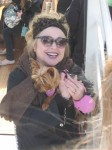Early Memories of the Homeless in Laguna

I remember as a kid driving back home to Laguna after a day at the Fun Zone up in Newport. After dark we rode the auto ferry to Balboa Island, crossed the old bridge into Corona del Mar and headed south on PCH.
Looking out the window of my dad’s Chevy, watching the moon on the ocean, about a mile north of Crystal Cove we saw small fires burning in a ravine leading to the beach. In the glow of the flames we could see men standing around, smoking, drinking, eating out of tin cans.
My dad saw the question on my face and said, “Looks like hobo camps in the Depression. Now it’s guys who came home from the war and don’t have jobs or a place to sleep.” Kids my age heard a lot about the Great Depression. It was 1956 and “the war” meant WWII, Korea, or both.
Back then the homeless were called vagrants, and when told to move on leaving was not optional. Vagrants deemed “drunks” or “crazy” were rousted and run out of town, or ended up in the county jail, some in state mental hospitals.
Some of the less unfortunate homeless outcasts found a way to recover from troubled lives here in Laguna, and you might say we had more than our share of drifters and misfits even then. But refugees who came here in the old days were not attracted by the scenery or public assistance.
It was more because Laguna was an isolated enclave where the original pioneering spirit of homesteaders and the bohemian exodus that followed still tolerated people looking to start over. Those with a work ethic and some ingenuity or creativity often were able to fit into the local scene, and even thrive.
My father had a prosperous business in Los Angeles and we were well off. But dad always had a friendly word and a generous tip for guys working in local gas stations, and women on their feet all day waiting tables, trying to make ends meet.
And somehow every handyman or painter my parents hired seemed to be a good-hearted exile from a shattered life. That included our gardener, Sam, who had lost his home while imprisoned in one of California’s federal concentration camps for Americans of Japanese descent during WWII.
In those days there were still a lot more working class folks and small family business owners in town, and a growing population of retirees with limited means. People without a lot lived pretty well, but it was both economical and considered unobjectionable to rent a room or give a day job to someone who came to town down on their luck.
One was Eiler Larsen, who some folks thought was crazy and should be run out of town. But he worked odd jobs, proved to have a theatrical flair, and as the town greeter he became an icon for tourists.
Though re-branded as “vagabond,” he was still a little scary to some, especially kids. It was a lot safer waving from the family car than approaching him on the street. Hardly the grandfatherly sort, but he won our hearts.
After he became a local legend, Larsen ate for free at the Cottage restaurant. When he got older, business owners and private donors made sure he had a place to stay. That was one of the first “supportive housing programs” for the homeless in Laguna Beach.
That was then and this is now. Today the civics of homelessness are not so simple. Instead of just shooting down imperfect preliminary solutions, the community needs to formulate a sound strategic overall legal and fiscal plan for managing homelessness.
If we do nothing, our town is going to end up less like Laguna Beach and more like Venice Beach.
Howard Hills is a third generation native of Laguna Beach and president of the Laguna Beach Republicans. Views expressed are personal opinion.
Will Housing Help Her?

By Jahn Levitt
I had a heart-wrenching experience this afternoon while walking into town. At the corner of Forest and Glennyre Streets, there was an elderly woman, swathed in torn rags, with open sores on her feet, and long, dirty toenails, pushing a walker, from which hung an assortment of old plastic bags and a worn purse. Laguna Beach’s very own homeless, with a face and broken body…. After I made my purchases in the drugstore, I walked towards the Coffee Pub, hoping to buy a cold drink. It is hot, very hot, today.
Once again I noticed this wretched woman, stopping at various parked cars, opening her plastic bags, removing coins, and inserting these coins in the parking meters. Why, I wondered, is she inserting her money into the parking meters of every car? It was painful to watch her, dressed in a heavy black rag for a coat on an impossibly hot day, visibly sweating, stopping every few feet and searching her bags for coins, and relentlessly inserting them in the parking meters.
I looked at others, tourists and residents, store owners and store employees, sitting down with a sweet and an iced drink. I realized my hesitation, and possibly that of the others in approaching this woman was because of her bizarre actions. Why wasn’t she using her money to buy a cold drink? Wasn’t she tired, and very warm?
I could not comprehend her actions, and sadly I realized she must have no touch with reality, living in a world she was creating for herself, oblivious to others.
If someone had fallen down on the sidewalk, wouldn’t I approach them and offer help? As I stood up to walk towards her with an unopened cold bottle of iced tea and a fresh cookie, she saw me approach and began to yell. She stumbled away on her terribly distended and sore feet, in broken sandals, which exaggerated their swelling, plastic bags in hand.
Would this woman be a candidate for the homeless shelter that is proposed? Would she be considered too broken, or someone who is delusional, and not a good candidate for accepting medication and rules of hygiene and interaction with others? Who might supervise her? Would she be able to conceptualize that there is a place to reside, in which she can take a warm shower, and eat a meal, and sleep in a protected environment?
I’ve read this sentiment so often in your Letters to the Editor. Yes, it is heartwarming, and sympathetic. But what about the woman in her rags with her swollen and bruised feet, who puts her pennies and dimes in the parking meters, and “lives” here? If this new proposed facility cannot help the neediest amongst us, what is its purpose and why should it be supported?
Yes, I certainly realize that we do the best we can do, and the Friendship Shelter has been successful and we must begin somewhere. In my religion we are taught to practice Tikkun Olam…to help restore the world, and that to save one person is as though one has saved the world. But what about the poor, crazy woman? How do we respond as a community when merely being homeless, hungry, needy and ill are not the exacting parameters for housing? Where will she be able to bathe, eat and sleep? Where will she call home?
A native New Yorker, Jahn Levitt was an editor at Random House Publishing, a buyer for Bullock’s Department Stores, and is presently involved with Family Promise OC and animal rescue groups.




